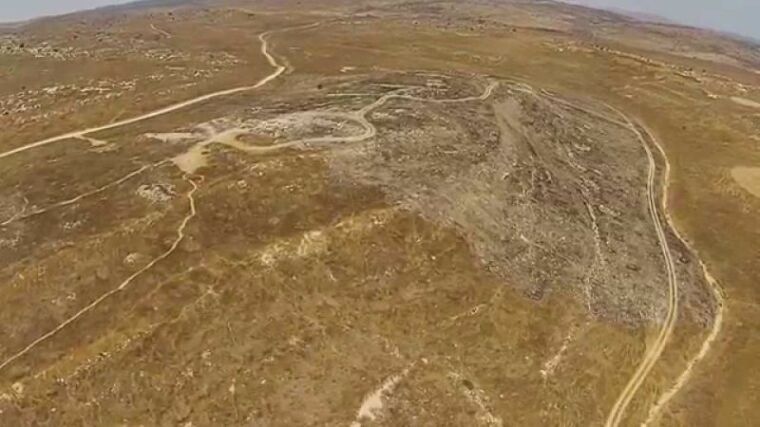New archaeological discovery confirms existence of Biblical city linked to King David, experts say

A large building discovered by archaeologists below the hills of Hebron, near Jerusalem, is believed to be part of an ancient settlement that has been linked to the Biblical King David.
Professor Avraham Faust, co-head of the archaeological dig, believes that the latest find confirms that the Bible is accurate, noting that it is a "part of the events in the Bible ascribed to the Kingdom of David."
Scholars have identified the city where the building was found as the Biblical city of Eglon, which is chronicled in the Bible as a part of a coalition that fought against the Israelites and was later listed as part of the tribe of Judah.
The archaeologists initially did not know what is hidden beneath the ground, but with the help of burrowing mole rats, they were able to sift through the soil brought to the surface by the rodents and find some clues as to what buried below.
Using radiocarbon dates of samples from the site, the experts have dated the building to the 10th century B.C., during the time of King David's rule, as recorded in the Bible.
"Until 25 years ago no one doubted that King David was a historical figure," Faust told Breaking Israel News.
"In the last 25 years or so, however, David's historicity, and especially the size of his kingdom, are hotly debated. The new discovery at Tel 'Eton, located in the Judean Shephelah to the east of the Hebron hills, seems to suggest that the highland kingdom controlled larger areas than some scholars believe," he added.
Faust clarified that there were no artifacts with the inscription of King David's name, but he argued that there are some signs of "social transformation" that can be linked to the time when the Biblical King was supposed to have existed.
"[T]he changes are consistent with larger regional changes, all connected with the highlands, and all taking place at a time the Kingdom of David was supposed to have to spread into this region," Faust told Breaking Israel News.
Several fortifications were found at the site during the early stages of excavations, suggesting that it was a significant area.
Many of the buildings found at the location dated to the eighth century B.C., a couple of centuries after the reign of King David, but further examinations revealed that the site was much older.
The latest discovery at the site was a well-constructed structure at the top of tel or an artificial mound, indicating that the location served as a regional administrative center.
The researchers also found a pottery bowl that is believed to be used in a ceremony asking God for protection of the building. The discovery of the artifact led the experts to believe that the building dated to the building to Canaanite Bronze Age and early Iron Age, and to the 10th century B.C. at the latest.
 Christians don't have to affirm transgenderism, but they can’t express that view at work: tribunal
Christians don't have to affirm transgenderism, but they can’t express that view at work: tribunal Archaeology discovery: Medieval Christian prayer beads found on Holy Island
Archaeology discovery: Medieval Christian prayer beads found on Holy Island Presbyterian Church in America votes to leave National Association of Evangelicals
Presbyterian Church in America votes to leave National Association of Evangelicals Over 50 killed in 'vile and satanic' attack at Nigerian church on Pentecost Sunday
Over 50 killed in 'vile and satanic' attack at Nigerian church on Pentecost Sunday Ukrainian Orthodox Church severs ties with Moscow over Patriarch Kirill's support for Putin's war
Ukrainian Orthodox Church severs ties with Moscow over Patriarch Kirill's support for Putin's war Islamic State kills 20 Nigerian Christians as revenge for US airstrike
Islamic State kills 20 Nigerian Christians as revenge for US airstrike Man who served 33 years in prison for murder leads inmates to Christ
Man who served 33 years in prison for murder leads inmates to Christ


 Nigerian student beaten to death, body burned over ‘blasphemous’ WhatsApp message
Nigerian student beaten to death, body burned over ‘blasphemous’ WhatsApp message 'A new low': World reacts after Hong Kong arrests 90-year-old Cardinal Joseph Zen
'A new low': World reacts after Hong Kong arrests 90-year-old Cardinal Joseph Zen Iran sentences Christian man to 10 years in prison for hosting house church worship gathering
Iran sentences Christian man to 10 years in prison for hosting house church worship gathering French Guyana: Pastor shot dead, church set on fire after meeting delegation of Evangelicals
French Guyana: Pastor shot dead, church set on fire after meeting delegation of Evangelicals ‘Talking Jesus’ report finds only 6% of UK adults identify as practicing Christians
‘Talking Jesus’ report finds only 6% of UK adults identify as practicing Christians Mission Eurasia ministry center blown up in Ukraine, hundreds of Bibles destroyed: 'God will provide'
Mission Eurasia ministry center blown up in Ukraine, hundreds of Bibles destroyed: 'God will provide' Church holds service for first time after ISIS desecrated it 8 years ago
Church holds service for first time after ISIS desecrated it 8 years ago Burger King apologizes for 'offensive campaign' using Jesus' words at the Last Supper
Burger King apologizes for 'offensive campaign' using Jesus' words at the Last Supper Uganda: Muslims abduct teacher, burn him inside mosque for praying in Christ’s name
Uganda: Muslims abduct teacher, burn him inside mosque for praying in Christ’s name